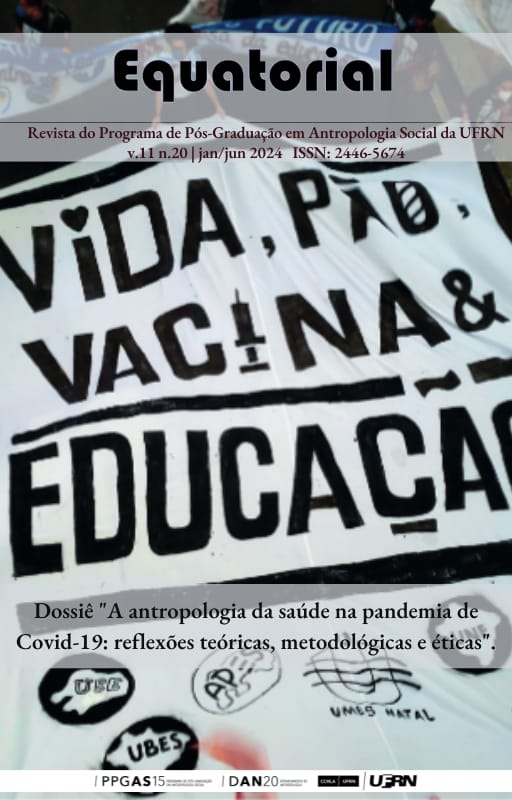“Hiva nimphela ovirela elapo”
social distancing practices and other “medicines” in the Covid-19 pandemic in Cabo Delgado, Mozambique
DOI:
https://doi.org/10.21680/2446-5674.2024v11n20ID33787Keywords:
Health anthropology, Ovirela elapo, Coronavirus, Distanciamiento social, MozambiqueAbstract
This article is the result of fieldwork carried out since 2012 in the community of Namanhumbir, Montepuez district, Cabo Delgado province, northern Mozambique. Going through a multitude of tensions and land conflicts between native communities, a ruby mining megaproject and the vientes, referring to those who come from outside the village, Namanhumbir was like the rest of the world, impacted by the repercussions of the discovery of the coronavirus at the end of 2019, which imposed restrictions on the mobility of its villagers, whose supplies depend on informal activities (commerce and family farming). Based on speeches and narratives on issues related to the strangeness of “the environment” and the use of “traditional” medicine practices, this text examines local representations of illness and death in the face of fears of the collapse of a national health system considered fragile. and unable to respond to the demands imposed by the lethality of a virus understood among local communities as “literally and metaphorically foreign”.
Downloads
References
CHAMBE, Zacarias Milisse. Entre “vientes” e nativos: mineração, mobilidade, violências e (re) existências em Montepuez, Moçambique. Tese (Doutorado em Ciências Sociais) — Universidade Estadual de Campinas, Instituto de Filosofia e Ciências Humanas, Campinas, 2021.
GUERREIRO, Clayton; CHAMBE, Zacarias Milisse; CASSALHO, João de Regina. Violência civilizatória e neoliberalismo: quando política e religião se encontram em Moçambique. Revista Debates, v. 16, n. 3, p. 17–34, 2022.
BUCHILLET, Dominique. Introdução: Representações e Práticas das Medicinas Tradicionais. In: BUCHILLET, Dominique (Org). Medicinas tradicionais e Medicina Ocidental na Amazônia. Belém: MPEG/CNPq/SCT/PR/CEJUP/UEP, 1991, pp. 63–64.
EVANS-PRITCHARD, Edward E. Bruxaria, oráculos e magia entre os Azande. Rio de Janeiro: Zahar, 2005 [1976].
GESCHIERE, Peter. The Modernity of Witchcraft: politics and the Occult in Postcolonial Africa. Charlottesville: University Press of Virginia, 1997.
GESCHIERE, Peter. Feitiçaria e modernidade nos camarões: alguns pensamentos sobre uma estranha cumplicidade. Afro-Ásia, n. 34, p. 9–38, 2006.
SERRA, Carlos (Ed.). Cólera e Catarse: infraestruturas de um mito nas zonas Costeiras de Nampula (1998–2020). Maputo: Imprensa Universitária, 2003.
HONWANA, Alcinda. Espíritos Vivos, Tradições Modernas: possessões de Espíritos e Reintegração Social Pós-Guerra no Sul de Moçambique. Maputo: Promédia, 2002.
ISRAEL, Paolo. The War of Lions: Witch-Hunts, Occult Idioms and Post-Socialism in Northern Mozambique. Journal of Southern African Studies, v. 35, n. 1, p. 155–174, 2009.
KOPENAWA, Davi; ALBERT, Bruce. A queda do céu: palavras de um xamã yanomami. Editora, São Paulo: Companhia de Letras, 2019.
LAST, Murray. The Professionalisation of African Medicine: Ambiguities and Definitions. In: LAST, Murray; CHAVUNDUKA, Gordon L. (Eds.). The Professionalisation of African Medicine. London: Routledge, 2019 [1986], pp. 1–26.
LOYOLA, Maria A. Medicina Tradicional e Medicinas Alternativas: Representações sobre Saúde e a doença, concepção e uso do corpo. In: BUCHILLET, Dominique. Medicinas tradicionais e Medicina Ocidental na Amazônia. Belém: MPEG/CNPq/SCT/PR/CEJUP/UEP, 1991, pp. 125–133.
MACCORMACK, Carol. The Articulation of Western and Traditional Systems of Health Care. In: LAST, Murray; CHAVUNDUKA, Gordon L. (Eds.). The Professionalisation of African Medicine. London: Routledge, 2019 [1986], pp. 151–162.
MARTÍNEZ, Francisco Lerma. O povo Makua e a sua Cultura: análise dos Valores culturais do povo Makua no Ciclo Vital, Maúa, 1971–1985. Maputo: Paulinas Editorial, 2009.
MAUSS, Marcel. Ensaio sobre a Dádiva: formas e razão da troca nas sociedades arcaicas. In: MAUSS, Marcel. Sociologia e Antropologia. São Paulo: Cosac Naify, 2003, pp. 184–315.
MENESES, Maria Paula G. “Quando não há problemas, estamos de boa saúde, sem fazer nada”: para uma concepção emancipatória da saúde e das medicinas. In: SANTOS, Boaventura Sousa; SILVA, Teresa Cruz e (Org.). Moçambique e a Reinvenção da Emancipação Social. Maputo: Centro de Formação Jurídica e Judiciária, 2004, p. 77–144.
NGUBANE, Harriet. The Predicament of the Sinister Healer: Some Observations on ‘Ritual Murder’ and the Professional Role of the Inyanga. In: LAST, Murray; CHAVUNDUKA, Gordon L. (Eds.). The Professionalisation of African Medicine. London: Routledge, 2019 [1986]. p. 189–204.
REYNOLDS, Pamela. The Training of Traditional Healers in Mashonaland. In: LAST, Murray; CHAVUNDUKA, Gordon L. (Eds.). The Professionalisation of African Medicine. London: Routledge, 2019 [1986]. p. 166–187.
RIVERS, William Halse R. Medicine, Magic and Religion. London: Routledge, 2001.
SEMALI, Innocent A. J. Associations and Healers: Attitudes towards Collaboration in Tanzania. In: LAST, Murray; CHAVUNDUKA, Gordon L. (Eds.). The Professionalisation of African Medicine. London: Routledge, 2019 [1986]. p. 87–97.
SERRA, Carlos. Cólera e Catarse: infraestruturas de um mito nas zonas Costeiras de Nampula (1998–2020). Maputo: Imprensa Universitária, 2003.
SHACK, William; SKINNER, Elliot (Ed.). Strangers in African Societies. London: University of California Press, 1979.
STAUGARD, Frants. Traditional Health Care in Botswana. In: LAST, Murray; CHAVUNDUKA, Gordon L. (Eds.). The Professionalisation of African Medicine. London: Routledge, 2019 [1986]. p. 51–86.
TURNER, Victor W. O processo ritual: estrutura e antiestrutura. Petrópolis: Editora Vozes, 1974.
VAN GENNEP, Arnold. Os Ritos de Passagens: estudo sistemático dos ritos da porta e da soleira. Petropólis: Editora Vozes, 1977.
WEST, Harry G. Kupilikula: governance and the invisible realm in Mozambique. Chicago: University of Chicago Press, 2005.
WEST, Harry G. “Governem-se vocês mesmos!”: Democracia e carnificina no Norte de Moçambique. Análise Social, v. XLIII, n. 2, p. 347–368, 2008.
WILSON, Monica. Nyakyusa Ritual and Symbolism. American Anthropologist, v. 56, n. 2, pp. 228–241, 1954.
WILSON, Monica. Strangers in Africa: Reflections on Nyakyusa, Nguni, and Sotho Evidence. In: SHACK, William; SKINNER, Elliot (Ed.). Strangers in African Societies. London: University of California Press, 1979. p. 51–66.
Downloads
Published
How to Cite
Issue
Section
License
Copyright (c) 2024 Zacarias Milisse Chambe

This work is licensed under a Creative Commons Attribution-NonCommercial-ShareAlike 4.0 International License.
Autores mantém os direitos autorais e concedem à revista o direito de primeira publicação, com o trabalho simultaneamente licenciado sob a Licença Creative Commons Attribution que permite o compartilhamento do trabalho com reconhecimento da autoria e publicação inicial nesta revista.

 Português (Brasil)
Português (Brasil) English
English Español (España)
Español (España)


